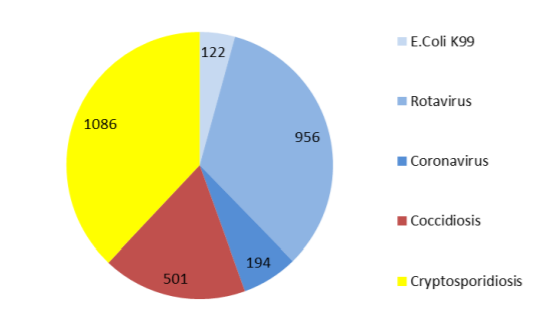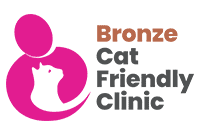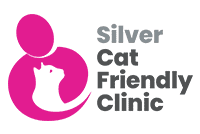Calf scour is a very common, and costly, problem in both dairy and beef calves in the UK with up to 33% mortality and poor growth rates. Scour or Diarrhoea is caused by damage to the cells lining the gut which results in reduced absorption of nutrients and increased fluid loss.
Causes of scour include Viruses (rotavirus, coronavirus), Parasites (Cryptosporidium, Coccidiosis), Bacteria (E-coli, salmonella) and nutritional. Mixed infections are common. Below is a summary of the most commonly diagnosed causes of calf scour in 2012. This shows Rotavirus and Cryptospiridium to be the most common diagnoses.

Summary of the common causes of scour in calves (NB this is only a guide calves don’t read textbooks!)
| Age of calf | Clinical signs | Possible diagnosis |
| Young calves 1-5 days | Acute yellow / white colour | E. coli (Bacteria) |
| 1-2 weeks, old 5-14 days | Severe scour | Rotavirus/Coronavirus |
| Few weeks old, 5-21 days | Variable/intermittent scour Zoonosis |
Cryptosporidium (PARASITE) |
| Any age | High fever Scour with blood Death, Zoonosis |
Salmonella (Bacteria) |
| Older calves > 18 days | Scour with blood/mucus Straining |
Coccidiosis (PARASITE) |
Excess volumes of milk/milk replacer, feeding at the wrong temperatures or concentrations, irregular feeding times and lack of hygiene can all result in nutritional scour.
Many of the pathogens causing scours are present on all farms and problems with disease only occur when the disease CHALLENGE is greater than the levels of the calves’ IMMUNITY. This is why disease often occurs more commonly in winter when challenge increases due to reduced cleanliness of housing.
Control
1. Reduce Challenge:
- Clean calving boxes/cows’ teats if suckling calves’
- Clean calf pens – clean/disinfect between calves
- Clean feeding equipment
- Isolate scouring calves
- Dairy calves – remove quickly from dam and dry cow yard into individual pens
- In beef herds if scour problems occurring at end of spring block consider calving outside if practical
2. Improve immunity
- COLOSTRUM – ensure all calves receive 3L of good quality colostrum within 6 hours. Tube calves/bucket feed to be certain this is achieved. Kingshay have shown that 60% of all calves that are left with their dam for 24hrs have inadequate antibody level.
- Use colostrometer to check colostrum quality
- Freeze good quality colostrum so you have plenty ready for use
- Consider vaccination – ROTAVEC – inject cows 12-3 weeks before calving to increase the amount of protective antibodies in colostrum against rotavirus, coronavirus and E.coli. You need to feed colostrum/milk for at least 4 days to maximise the benefits of vaccine.
- Reduce stress – weaning/mixing groups/draughts/high or low temperatures
- Offer calf concentrate and forage in the first week and fresh, clean water from day one.
Treatment
****REHYDRATION****
DEHYDRATION is the killer in calf scours. Administration of oral rehydration therapy is the MOST IMPORTANT treatment. Continue milk feeding – this provides energy for growth and also nutrients for repair of the damaged gut, use rehydration therapy that can be mixed in milk or supplementary feed with electrolytes in-between milk feeds.
- If the calf is collapsed IV fluids may be required contact the surgery to discuss
Other treatments
Since most causes of scour are viral/protozoal antibiotics are not usually indicated unless there is evidence of bacterial causes – please discuss this with your vet.
Halocur – This reduces the severity of scour due to CRYPTOSPORIDIA. It also reduces shedding of oocysts thus reducing environmental contamination. Treatment involves oral dosing once daily for 7 days and appears effective. Halocur can be used as a preventative but results do seem to be more mixed. Probiotics/binders etc – eg Recofast – Provides nutritional support, rehydration and toxin absorption to help recover from scour
Diagnosis
If you are having scour problems contact us at the surgery.
We can do in house faecal analysis of samples to help ID the pathogens involved in your scour problems and can visit to give advice about management. If animals have died post-mortem exam can also be a useful diagnostic tool.






